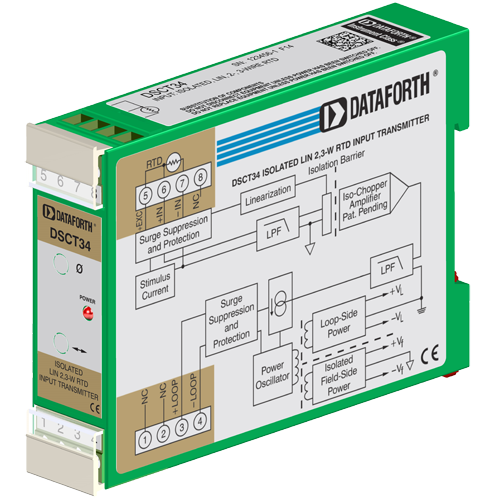Each DSCT34 RTD input transmitter provides a single channel of RTD input which is filtered, isolated, amplified, linearized, and converted to a process current output. Signal filtering is accomplished with a five-pole filter, which provides 85dB of normal-mode rejection at 60Hz and 80dB at 50Hz. An anti-aliasing pole is located on the field side of the isolation barrier, and the other four are on the process loop side. After the initial field-side filtering, the input signal is chopped by a proprietary chopper circuit. Isolation is provided by transformer coupling, again using a proprietary technique to suppress transmission of common mode spikes or surges.
RTD excitation is provided from the transmitter using a precision current source. The excitation currents are very small (0.26mA max for 100 ohm Pt and 120 ohm Ni) which minimizes self-heating of the RTD. Linearization is achieved by creating a non-linear transfer function through the module itself. This non-linear transfer function is configured at the factory and is designed to be equal and opposite to the specific RTD non-linearity. Lead compensation is achieved by matching two current paths thus canceling the effects of lead resistance.
The specifications listed are for a 3-wire connection. A 2-wire connection of the RTD to the module is also possible and is achieved by adding a jumper between pin 5 (+EXC) and pin 6 (+IN) on the terminal block and connecting the RTD leads between pin 6 (+IN) and pin 7 (-IN). The 2-wire connection nullifies the lead resistance compensation feature of the module.
Special input and output circuits on the DSCT34 transmitters provide protection against accidental connection of power-line voltages up to 240VAC and against transient events as defined by ANSI/IEEE C37.90.1. Signal and loop power lines are secured to the module using screw terminals, which are in pluggable terminal blocks for ease of system assembly and reconfiguration.
The modules have excellent stability over time and do not require recalibration, however, zero and span settings are adjustable up to ±3% to accommodate situations where fine-tuning is desired. The adjustments are made using potentiometers located under the front panel label and are non-interactive for ease of use.

